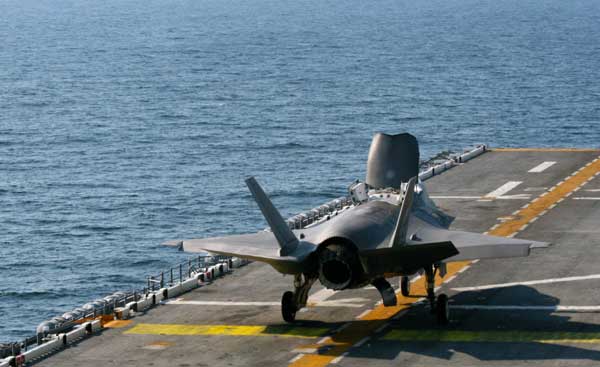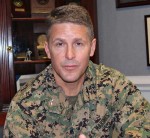
01/31/2012 – During the week of Second Line of Defense Interviews in early January 2012, Col. Bradley Weisz, Deputy Commander, Expeditionary Strike Group TWO, explains the approach being followed in support of BA-2012. The Colonel discusses the role of the Expeditionary Strike Group and the allies in the exercise.
The Colonel focuses on the strike capability already in place to allow a push approach for the sea base in the littorals. He discusses as well the impacts of the new air assets – MV-22B Osprey, F-35B, and the CH-53K – in significantly augmenting the template being tested.
SLD: Could you provide our readers with a sense of your background?
Col. Weisz: My background is Aviation Command and Control, I’ve been in the Marine Corps roughly 23 years, and have been with ESG-2 now for about 14 to 15 months. I came here out of Afghanistan with ISAF as well as Okinawa with 1st Marine Aircraft Wing. The majority of my time in the Corps has been spent with the Marine Aircraft Wing.
SLD: The ESG being used in this exercise is a relatively newly crafted entity and certainly was not the concept in place when the last big amphibious exercise occurred a decade ago. Can you provide a sense of what the ESG is in current conditions?
Col. Weisz: Admiral Scott has three primary missions that the command truly focuses on daily. His primary focus is to make sure that ESG-2 is operationally ready with a rapidly deployable command element that can support any sort of crisis response. We are operating across the range from humanitarian assistance and disaster relief to peace operations to major combat operations. We need to be able to deploy on a moment’s notice. He has a good mix of blue green officers and staff that are fully trained and ready to deploy with him on board amphibious warships to support whatever the crisis might be.
He also has another very important mission where he has to maintain oversight and management of all East Coast amphibious warship readiness, so his staff is heavily engaged with regard to that on a daily basis. He has these independent deployers, what we can single ship operations, going out to conduct theater security cooperation events and exercises in Central and South America as well as Africa, and they stay very busy doing that theater security cooperation mission.
Additionally, about every six to seven months he has to send out an amphibious ready group, what we call a three warship ARG, with embarked Marines from the Marine Expeditionary Unit, the MEU. It is absolutely critical that those ships maintain the highest state of readiness and are always ready to deploy. That’s predominantly where the staff has to spend the majority of their time and attention planning, coordinating and de conflicting those readiness challenges.
SLD: Does he have a specific geographical focus on the eastern side of the U.S. or is he a force provider for combatant commanders?
Col. Weisz: He actually does both. He has 14 amphibious warships here on the East Coast that he’s responsible for, and this includes four LHDs, four LPDs and six LSDs, and then he also has responsibility for supporting the NorthCom Commander, that area of responsibility here on the East Coast of the United States. He is responsible for providing support from humanitarian assistance disaster relief operations to defense support of civilian authorities missions.
He’ll work with other fleets, like Commander Fourth Fleet out of Mayport, Florida that has that SouthCom responsibility and perspective. He’ll work closely with them providing amphibious warships and personnel capabilities for those specific needs, but he also support ops in the Mediterranean Sea, and supports the EUCOM and AFRICOM perspective.
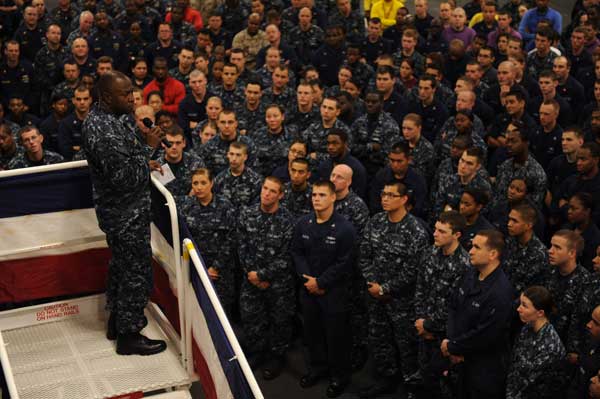 Rear Adm. Kevin Scott, commander of Expeditionary Strike Group 2, addresses sailors aboard the amphibious assault ship USS Wasp in the ship’s hangar bay. Wasp was transiting back to Norfolk after standing by to provide assistance in areas affected by Hurricane Irene. (Credit: USN Visual Service, 09/02/11)
Rear Adm. Kevin Scott, commander of Expeditionary Strike Group 2, addresses sailors aboard the amphibious assault ship USS Wasp in the ship’s hangar bay. Wasp was transiting back to Norfolk after standing by to provide assistance in areas affected by Hurricane Irene. (Credit: USN Visual Service, 09/02/11)
Finally, Admiral Scott is truly the voice for amphibious expertise here on the East Coast. When Admiral Harvey of Fleet Forces Command has something dealing with amphibious forces, he looks at ESG-2, specifically Admiral Scott, and says “Hey, you’re my belly button for dealing and handling this.”
(For our interview aboard the USS Wasp with Admiral Scott, see https://sldinfo.com/admiral-scott-and-the-arg/.)
SLD: And clearly the evolving aviation assets and CONOPS for the Gator Navy are evolving the capability to become more of a strike asset as well.
Col. Weisz: That is a good assessment, and as we add electronic warfare capability from a big-deck amphib, more change will even occur. You take a look at what took place in Libya, the seven AV-8B Harriers that they had on board the USS KEARSARGE, and the work that they did in and out of Libya was just absolutely phenomenal. But this is just the beginning of a new phase, a new era.
The big deck amphib with the STOVL capability – the short take-off and vertical landing capability – provides tremendous power projection for the United States and our naval services, and more and more folks are catching on and noticing this.
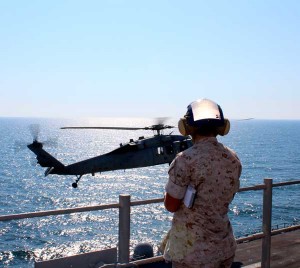
When we will put an F-35 Bravo out there that can provide all six functions of Marine aviation capability in a single platform, it just gives you a phenomenal capability, especially the electronic warfare mission. Then an amphibious ready group or a big-deck amphib could be in support of a carrier strike group until they actually get up to speed, and are ready to perform some of those missions that historically only large deck carriers, CVNs, have done.
SLD: An aspect of the exercise, which I am looking forward to observe is the new role for the supply ships. In a classic Gator Navy, the supply ships are sort-of floating Walmarts. In the new concept, and with the MV-22 certified TAK-E ships, these ships can become integral to the operations of the fleet and allow the strike ships to offload supplies which they have had to carry before and now can be supplied on a very timely basis by the support elements of the seabase.
Col. Weisz: You’re getting to the sea-basing concept that obviously we’ve been highlighting, that we are very excited about. With your supply ships like the T-AK, T-AKE, T-AVB and LMSR out there providing direct support to your amphibious forces, you significantly enhance and enable your Blue Green capabilities, especially when supporting combat operations.
The aviation combat element obviously allows the supply ships to be used differently. We can sustain ourselves, resupply ourselves, and conduct an operation as well as any land based capability, especially when you compare it to what recently took place in Libya, how close the Harriers were to Libya, how effective they were, it’s unbelievable.
We can use the MV-22B to develop that logistic supply chain. In Libya, you had a Big Deck LHD sitting right off the coast. You had an MV-22B resupplying, sustaining it, and the sortie rate was 3 to 4 times what we would normally expect.
SLD: An interesting aspect of the exercise is the interaction between the large deck carrier and the amphibious fleet. Here the large deck carriers – the real one is Big E and there is a virtual one as well – are in support of the insertion of force. Rather than logging precision strike weapons, now the forces being asserted ashore in a maneuver operation are so to speak the precision strike weapons.
Col. Weisz: That’s a great point. It’s the first exercise we’re really going to show the true ESG concept where you have the Amphibious Task Force Commander with a lot of strike capability. The carrier strike group will actually be on position before we even get into the theater, conducting strike, ISR and supporting operations.
We will arrive and start conducting our amphibious mission, as you say the littoral mission, and the carrier strike group will be in support of us.
In fact, a lot of our aviation support will be coming from the carrier as well as from the Air Force CFACC. BA 12 is a joint operation, amphibious operations are very joint in nature, always have been, always will. It just isn’t about Navy and Marine Corp going in and doing this, we’re tapping heavily into joint sources, special operations forces and other maritime forces to support our mission. But again, they are supporting us vice, going in there, and you’re now falling under the Carrier Strike Group, and they’re going to run with it.
We will be able to utilize those strike and ISR assets from the Carrier Strike Group like the Enterprise to conduct some of our pre-shaping operations before we arrive in the Amphibious Objective Area, the AOA. So it sets the right conditions as we start coming ashore. You know last thing we want to do is come ashore, and have a pop-up anti-ship cruise missile, pop-up mobile coastal defense cruise missile site, or some highly capable mobile surface-to-air missile site, and then we’ve got to deal with it immediately, time sensitive, right now.
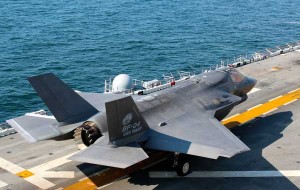
We want to eliminate that threat as soon as possible, as much as possible and then set some conditions, postures and readiness where if something like that does pop up again, something that we had not planned for, then guess what, we have the capability to neutralize it and take it out.
And this gets into that F-35 Bravo impact down the road. You will have that immediate strike asset capability that has both strike and ISR that gives you the immediate capacity to annihilate or neutralize that threat; it will be great at time sensitive targeting.
SLD: Could you talk about the role of allies in the exercise?
Col. Weisz: Right now we have ten coalition countries that are participating in BA 12. The French have come in heavy with the FS MISTRAL, a very capable LHD warship, the ones the Russians are buying a few of. And the French Amphibious Task Force will provide a significant landing force contingent aboard the ship, consisting of ground, aviation and combat service support capabilities, all good to go.
Canada’s going to bring down a couple mine counter measure ships, and we are going to look at the threat of mines in the littorals, shallow and deep water. We will especially look at the threat of cheap, easy to deploy mines, and how do you deal with them.
The British will also be here, the Spanish, the Italians, the Netherlands are going to come in hot and heavy with a bunch of participants, staff and observers. And as you look to the Pacific theatre for Coalition partner participation, we have both Australia and New Zealand coming. This provides a solid base of coalition participants.
In today’s operating environment, there always will be coalition partners, and this is what BOLD ALLIGATOR highlights, that there are a lot of amphibious capabilities out there, e.g. with the European Amphibious Initiative, the EAI. There are a lot of great Maritime and Force Projection capabilities that we can tie into, and that are exactly what Admiral Harvey, and Lieutenant General Hejlick wanted to do from the very beginning with BA 12.
In fact, the French are leading our initial land assault when we go ashore to secure the very first landing force objective, so it’s good to see the coalition taking the lead; and for us to observe and see how they do business first-hand, up-close and really personal.
How do they command and control their forces, how do they share information data, how do they resupply and all of those dynamics? Something that also comes with that coalition team is how well information ops can be conducted, and we think the French and all the other coalition countries have a great capability when conducting information ops against our adversaries.
It’s constantly a give and take, some times the simplest things that you would think would be easily accomplished take a little extra coordination and cooperation to ensure success because we don’t always see eye-to-eye.
So that’s what’s bringing the coalition provides us with, in part, a different perspective. That different war fighting perspective that we like to see and critique, you want somebody else who sees it from a different perspective than yours.
SLD: Final question: the command appears to be truly joint. The head of the command is Navy and you are a Marine. Could you explain the nature of the command?
Col. Weisz: Both the Navy and Marine Corps have agreed to get back to our grassroots of amphibious operations, our traditional roots as fighters from the sea, get back to this thing the Commandant of the Marine Corps and the Chief of Naval Operations call amphibiocity, or whatever you want to call it.
And here at the Expeditionary Strike Group we have a staff of about 65 people. So you’ve got 55 Sailors, 9 Marines and a coalition officer from the Netherlands, and attracting, developing and maintaining a strong blue-green team is Admiral Scott’s No. 1 priority, the gold standard. Everything we do is blue-green, so it only makes sense to have a Deputy that’s a Marine Officer. It’s enhances staffing and operations because the Marine Officer brings a totally different perspective than what the Navy side traditionally experiences with a blue only staff.
And you’ll see within the staff here, you’ve got a good mix of MAGTF experts from the green side, aviation, communications, logistics, intelligence, command and control, so there’s good mix from that Marine side to give Admiral Scott the knowledge, information and situational awareness that he needs in order to make timely and accurate decisions.
The same thing is true on the blue side. When you take a look at the blue staff here, a great mix of aviation, surface, subsurface, communications, intelligence, logistics, all kinds of experts bought to a single table, probably the best mix of any strike group in the Navy when you think about mixing that blue-green team.
Featured Image: Two AV-8B Harriers, attached to the Air Combat Element of the 24th Marine Expeditionary Unit (MEU), prepare for flight operations aboard amphibious assault ship USS Nassau (LHA 4). The 24th MEU is participating in Nassau Strike Group’s Composite Unit Training Exercise. COMPTUEX provides a realistic training environment to ensure the strike group is capable and ready for deployment.
Credit: USN Visual Service, 12/9/07


